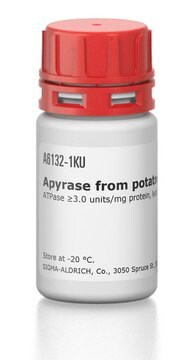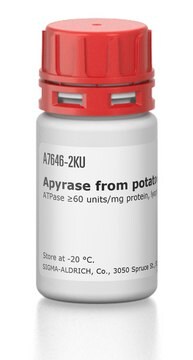A2230
Apyrase from potatoes
High Activity, ATPase ≥600 units/mg protein, lyophilized powder
Synonym(s):
Adenosine 5′-diphosphatase, Adenosine 5′-triphosphatase
Sign Into View Organizational & Contract Pricing
All Photos(1)
About This Item
CAS Number:
MDL number:
UNSPSC Code:
12352204
NACRES:
NA.54
Recommended Products
biological source
potato
form
lyophilized powder
quality
High Activity
ATPase activity
≥600 units/mg protein
secondary activity
≥50 % of base activity ADPase
composition
protein, ≥30%
foreign activity
Acid Phosphatase ≤2% of base activity
shipped in
wet ice
storage temp.
−20°C
Looking for similar products? Visit Product Comparison Guide
Application
Apyrase is used to hydrolyze nucleoside triphosphates and diphosphates. Apyrase, from Sigma, has been used in inhibition studies of platelet-aggregation . Product A2230 is a high activity apyrase.
At least two isoenzymes are found in different varieties of S. tuberosum: one with a high ATPase/ADPase ratio (∼10) and another with a low ratio (∼1).
Reaction: ATP → ADP+Pi → AMP+2Pi.
Reaction: ATP → ADP+Pi → AMP+2Pi.
Biochem/physiol Actions
Apyrase is found in all eukaryotes and some prokaryotes. Apyrase, from potato, has a crucial role in regulating growth and development. Apyrase is involved in the inactivation of synaptic ATP as a neurotransmitter following nerve stimulation and in the inhibition of ADP induced platelet aggregation to prevent thrombosis . Divalent metal ions are required for activity and best activity is observed with calcium ion at 5 mM.
Packaging
Sold on the basis of ATPase units.
Unit Definition
One unit will liberate 1.0 μmole of inorganic phosphate from ATP or ADP per min at pH 6.5 at 30 °C.
Physical form
Lyophilized powder containing potassium succinate buffer salts.
Preparation Note
Derived from red potato
Signal Word
Danger
Hazard Statements
Precautionary Statements
Hazard Classifications
Resp. Sens. 1
Storage Class Code
11 - Combustible Solids
WGK
WGK 3
Flash Point(F)
Not applicable
Flash Point(C)
Not applicable
Choose from one of the most recent versions:
Already Own This Product?
Find documentation for the products that you have recently purchased in the Document Library.
Customers Also Viewed
Mathieu F Chevalier et al.
Blood, 121(1), 29-37 (2012-10-09)
Natural regulatory T cells (Tregs) participate in responses to various chronic infections including HIV. HIV infection is associated with a progressive CD4 lymphopenia and defective HIV-specific CD8 responses known to play a key role in the control of viral replication.
Nicholas J Roberts et al.
Plant physiology, 161(1), 556-567 (2012-11-09)
Nodulation in legumes requires the recognition of rhizobially made Nod factors. Genetic studies have revealed that the perception of Nod factors involves LysM domain receptor-like kinases, while biochemical approaches have identified LECTIN NUCLEOTIDE PHOSPHOHYDROLASE (LNP) as a Nod factor-binding protein.
Tsan-Yu Chiu et al.
Plant & cell physiology, 53(11), 1913-1925 (2012-10-05)
Nucleoside triphosphate diphosphohydrolases (NTPDases; apyrases) (EC 3.6.1.5) hydrolyze di- and triphosphate nucleotides, but not monophosphate nucleotides. They are categorized as E-type ATPases, have a broad divalent cation (Mg(2+), Ca(2+)) requirement for activation and are insensitive to inhibitors of F-type, P-type
Ana Carolina Ribeiro Gomes Maia et al.
Parasitology international, 62(1), 44-52 (2012-09-22)
We identified a shared B domain within nucleoside triphosphate diphosphohydrolases (NTPDases) of plants and parasites. Now, an NTPDase activity not affected by inhibitors of adenylate kinase and ATPases was detected in Leishmania infantum promastigotes. By non-denaturing gel electrophoresis of detergent-homogenized
Gabriane Nascimento Porcino et al.
Experimental parasitology, 132(2), 293-299 (2012-08-28)
Nucleoside triphosphate diphosphohydrolase (NTPDase) activity was recently characterized in Leishmania (Viannia) braziliensis promastigotes (Lb), and an antigenic conserved domain (r82-121) from the specific NTPDase 1 isoform was identified. In this work, mouse polyclonal antibodies produced against two synthetic peptides derived
Our team of scientists has experience in all areas of research including Life Science, Material Science, Chemical Synthesis, Chromatography, Analytical and many others.
Contact Technical Service












